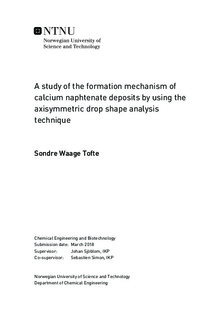| dc.description.abstract | New batches of ARN were extracted with a yield of 15-17 % and with a purity of 92-93 %. The axisymmetric drop shape analysis (ADSA) technique was used on different samples of ARN, xylene and asphaltenes to study the dilational interfacial rheology. The results from the experiments confirm that ARN cause the calcium napthenate gel formation when the carboxylate groups in ARN react with calcium ions from the buffer. A strong gel is formed for 2.5microM ARN with a long exchange time (5400 seconds) and the adsorption layer of ARN is being reorganized. The presence of asphaltenes in a mixture of ARN and asphaltenes prevents gel formation. A buffer with pH 6 and 7 can be used with a concentration of 25 microM ARN, but for a buffer with pH 8 the concentration is at the limit of what can be studied at 9 microM-10 microM ARN.
7.5 microM ARN-asphaltenes and 7.5 microM ARN-xylene was found to have different interfacial tension during the adsorption. This could be a result of pollution. A new procedure with more thorough cleaning was created to prevent pollution of asphaltenes. Asphaltenes are able to desorb gel that is already formed, even when the gel was strong at high ARN concentration (10 microM) and after coalescence. Coalescence with ARN is increasing the gel formation significantly. This may be caused by a new adsorption layer, probably multilayer formation. The time to desorb the formed gel is increased when the ARN concentration is increased because the gel is stronger. The axisymmetric drop shape analysis (ADSA) technique can be used with an ARN concentration of 10 microM for pH 8 with a contracted volume to look at the gel formation during coalescence. Pictures of the drop and the interfacial tension values during the experiments show that the shape often is hard to control after contraction for 10.0 microM ARN, but the shape is controlled properly for 7.5 microM ARN. The interfacial tension is calculated to be significantly lower when the shape is longer. The axisymmetric drop shape analysis (ADSA) technique is hard to use for contraction with higher concentration of ARN because the shape of the drop is hard to control. The profile error from the software can be used to determine if the drop got a good shape after contraction. | |

